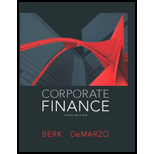
Concept explainers
Your brother wants to borrow $10,000 from you. He has offered to pay you back $12,000 in a year. If the cost of capital of this investment opportunity is 10%, what is its
To calculate: The net present value and internal rate of return
Introduction:
NPV and IRR help to make capital-budget decisions. It would choose an alternative or an investment to increase the value of an enterprise.
Answer to Problem 1P
The NPV is 909.09 and IRR is 20%.
Explanation of Solution
Given information: Person X’s brother wishes to borrow $10,000 from Person X and offered to pay back $12,000 per year. The cost of capital for the investment opportunity is 10%.
Formula to compute the NPV:
Compute the NPV:
Hence, the NPV is $909.09.
Formula to compute IRR:
Compute the IRR:
Hence, the IRR is 20%.
Determine the maximum deviation allowable in the cost of capital without making any changes to the decision:
The calculated internal rate of return is 20%. Hence, the cost of capital can be increased up to 10% leaving the decision unchanged.
Want to see more full solutions like this?
Chapter 7 Solutions
Corporate Finance
- PLEASE ANSWER THE COLUMN FULLY AND CORRECTLY PLEASE DO THE RIGHT CALCULATION DOUBLE CHECK AS WELL TO GIVE ME THE RIGHT ANSWER REQUIRED: Given the following information, what are the NZD/SGD currency against currency bid-ask quotations? Note: Do not round intermediate calculations. Round your answers to 4 decimal places. Bank Quotations American Terms European Terms Bid Ask Bid Ask New Zealand dollar 0.733 0.7340 1.3870 1.3884 Singapore dollar 0.6186 0.6191 1.6423 1.6436 answer Bid Ask New Zealand dollar ? ? Singapore dollar ? ?arrow_forwardAbout this Assignment For the Corporate Finance 301 assignment, you will submit a research paper that analyzes and discusses organizational financial risks. You will apply knowledge acquired in the course and use the concepts of multiple financial risks as the basis of research and analysis. The research paper should follow APA formatting style. Audience: upper-level business students. Project Prompt Write a 1,000-1,200-word analysis discussing financial risk concepts and assess the impact of the different financial risks on an organization. For this assignment, you will structure your assignment using four research paper sections associated with corporate risk management, as studied in the course. Base your research paper on the financial statements analyzed in Corporate Finance 301 assignment 2 and apply the knowledge acquired in the analysis. Define each financial risk, discuss the risk associated components, and evaluate the financial risks and how they affect the corporation's…arrow_forwardBobby Nelson, made deposits of $880 at the end of each year for 6 years. Interest is 6% compounded annually. What is the value of Bobby’s annuity at the end of 6 years?arrow_forward
- 1. Find the future value if $1,250 is invested in Simple interest account paying 6.5%: a. for 5 years b. for 20 years 2. Find the future amount $ 35,000 is invested for 30 years at 4.25% compounded: a. annually b. Quarterly c. monthly d. weekly 3. How much should be put into an account today that pays 7.75% compounded monthly if you need $10,000 in 5 years. 4. Find the effective rate for: a. 5.75% compounded quarterly b. 6.25% compounded daily. 5. $50 is invested at the end of each month into an account paying 7.5% compounded monthly. How much will be in the account after 5 years?…arrow_forwardSolve step by step no aiarrow_forwardDont use ai solve itarrow_forward
- Principles of Accounting Volume 2AccountingISBN:9781947172609Author:OpenStaxPublisher:OpenStax College
